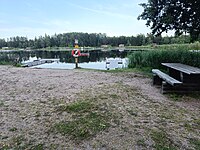Tag:leisure=bathing_place
| Description |
|---|
| An outdoor location without significant facilities that is commonly used for bathing; a wild swimming spot |
| Group: leisure |
| Used on these elements |
| Useful combination |
|
| See also |
| Status: in use |
| Tools for this tag |
|
A place where you can bathe[1]/take a bath/swim in natural water (lake, sea, reservoir etc.).
This tag should only be used for bathing places with no or limited facilities (toilets, showers, etc.), for other cases use amenity=public_bath or leisure=beach_resort. Do note however that there is no hard limit when a bathing place becomes a public bath or beach resort, and the exact definition might also differ between countries. See Swimming and bathing for more information and comparisons between these tags.
While the name of the tag suggests that a bathing place is only for playing in the water or washing oneself, in practice a bathing place also refers to the beach (if present), mowed grass area, and any facilities. Use leisure=swimming_area to map the water itself, but only if it is designated.
How to map
In most cases, place a ![]() and tag it with leisure=bathing_place and any additional tags. The node can be placed in the middle or at the entrance to the bathing place.
and tag it with leisure=bathing_place and any additional tags. The node can be placed in the middle or at the entrance to the bathing place.
If the bathing place as very wide (for example, a long beach) it may instead be mapped as a ![]() sharing nodes with the coastline (or beach/water boundary).
sharing nodes with the coastline (or beach/water boundary).
Only if the entire bathing place (including both parts on land and in water, see the requirements for leisure=swimming_area) are distinct and verifiable may it be mapped with ![]() .
.
Add tags for available facilities, as well as name=* if known. Other relevant tags may be nudism=*.
EU Bathing Waters Directive
In the EU, all formal bathing places should be provided and have a unique identifier. This identifier can be added in using the ref:EU:bwid=* tag. See also the Wikidata project for adding bathing places to Wikidata: [1]
Examples
Facilities
leisure=bathing_place should only be used for locations with limited facilities, though this limit is soft and can differ between countries. See Swimming and bathing for more on when to map with another tag.
Depending on the available facilities the following tags may be added to the leisure=bathing_place:
- shower=yes/no
- toilets=yes/no
- bbq=yes/no
- drinking_water=yes/no
- picnic_table=yes/no
Additionally, these features may also be mapped separately.
Formal or informal
In general, a bathing place should somehow be officially designated, for example by the local government, and have a sign or similar.
However, there are also many places that are not officially designated, for example because the local government does not want to take responsibility for the place or even because it is actively dangerous to swim there, but are still used by people. Such a place may be tagged with leisure=bathing_place, but should additionally be tagged with informal=yes. Keep in mind, however, that this does not mean that any place that happens to be suitable for bathing (like every bend in a river that has a bit of sand) should be mapped. There is no hard limit on when to tag an informal bathing place, but some good examples when it is accepted to do so (usually most of these will be true):
- It's generally known (at least by most people living nearby)
- It has a generally accepted name
- It's suitable for bathing, more so than the surroundings (for example because a path is leading there, or because it's the only beach on a lake that otherwise is completely surrounded by vegetation)
- It's regularly used for bathing
Remember that while it may not be a clear bathing place when empty, it might be full of people bathing at another time. A good rule of thumb: Don't map unless you see people bathing, don't remove unless it's clear no one will bathe here.
If a bathing place is used as such despite it being dangerous it is recommended to add an appropriate hazard=* tag.
Disambiguation
There are several other tags that may be more suitable:
See Swimming and bathing for a comparison of these tags.



